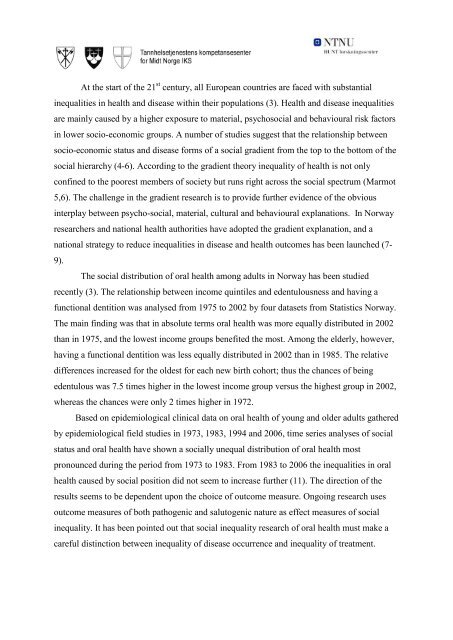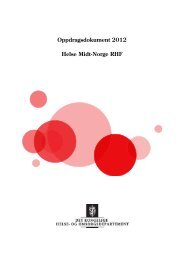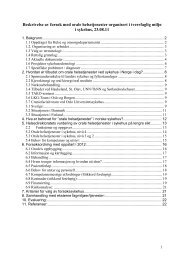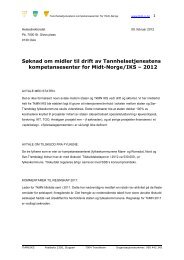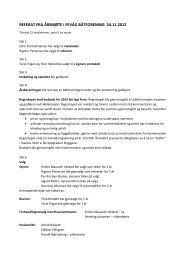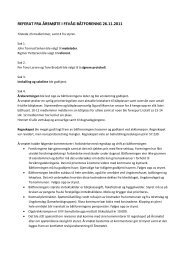Oral Health in Norway. The HUNT Study.
Oral Health in Norway. The HUNT Study.
Oral Health in Norway. The HUNT Study.
Create successful ePaper yourself
Turn your PDF publications into a flip-book with our unique Google optimized e-Paper software.
At the start of the 21 st century, all European countries are faced with substantial<br />
<strong>in</strong>equalities <strong>in</strong> health and disease with<strong>in</strong> their populations (3). <strong>Health</strong> and disease <strong>in</strong>equalities<br />
are ma<strong>in</strong>ly caused by a higher exposure to material, psychosocial and behavioural risk factors<br />
<strong>in</strong> lower socio-economic groups. A number of studies suggest that the relationship between<br />
socio-economic status and disease forms of a social gradient from the top to the bottom of the<br />
social hierarchy (4-6). Accord<strong>in</strong>g to the gradient theory <strong>in</strong>equality of health is not only<br />
conf<strong>in</strong>ed to the poorest members of society but runs right across the social spectrum (Marmot<br />
5,6). <strong>The</strong> challenge <strong>in</strong> the gradient research is to provide further evidence of the obvious<br />
<strong>in</strong>terplay between psycho-social, material, cultural and behavioural explanations. In <strong>Norway</strong><br />
researchers and national health authorities have adopted the gradient explanation, and a<br />
national strategy to reduce <strong>in</strong>equalities <strong>in</strong> disease and health outcomes has been launched (7-<br />
9).<br />
<strong>The</strong> social distribution of oral health among adults <strong>in</strong> <strong>Norway</strong> has been studied<br />
recently (3). <strong>The</strong> relationship between <strong>in</strong>come qu<strong>in</strong>tiles and edentulousness and hav<strong>in</strong>g a<br />
functional dentition was analysed from 1975 to 2002 by four datasets from Statistics <strong>Norway</strong>.<br />
<strong>The</strong> ma<strong>in</strong> f<strong>in</strong>d<strong>in</strong>g was that <strong>in</strong> absolute terms oral health was more equally distributed <strong>in</strong> 2002<br />
than <strong>in</strong> 1975, and the lowest <strong>in</strong>come groups benefited the most. Among the elderly, however,<br />
hav<strong>in</strong>g a functional dentition was less equally distributed <strong>in</strong> 2002 than <strong>in</strong> 1985. <strong>The</strong> relative<br />
differences <strong>in</strong>creased for the oldest for each new birth cohort; thus the chances of be<strong>in</strong>g<br />
edentulous was 7.5 times higher <strong>in</strong> the lowest <strong>in</strong>come group versus the highest group <strong>in</strong> 2002,<br />
whereas the chances were only 2 times higher <strong>in</strong> 1972.<br />
Based on epidemiological cl<strong>in</strong>ical data on oral health of young and older adults gathered<br />
by epidemiological field studies <strong>in</strong> 1973, 1983, 1994 and 2006, time series analyses of social<br />
status and oral health have shown a socially unequal distribution of oral health most<br />
pronounced dur<strong>in</strong>g the period from 1973 to 1983. From 1983 to 2006 the <strong>in</strong>equalities <strong>in</strong> oral<br />
health caused by social position did not seem to <strong>in</strong>crease further (11). <strong>The</strong> direction of the<br />
results seems to be dependent upon the choice of outcome measure. Ongo<strong>in</strong>g research uses<br />
outcome measures of both pathogenic and salutogenic nature as effect measures of social<br />
<strong>in</strong>equality. It has been po<strong>in</strong>ted out that social <strong>in</strong>equality research of oral health must make a<br />
careful dist<strong>in</strong>ction between <strong>in</strong>equality of disease occurrence and <strong>in</strong>equality of treatment.


